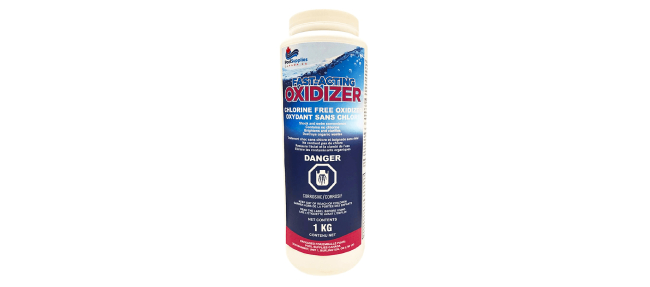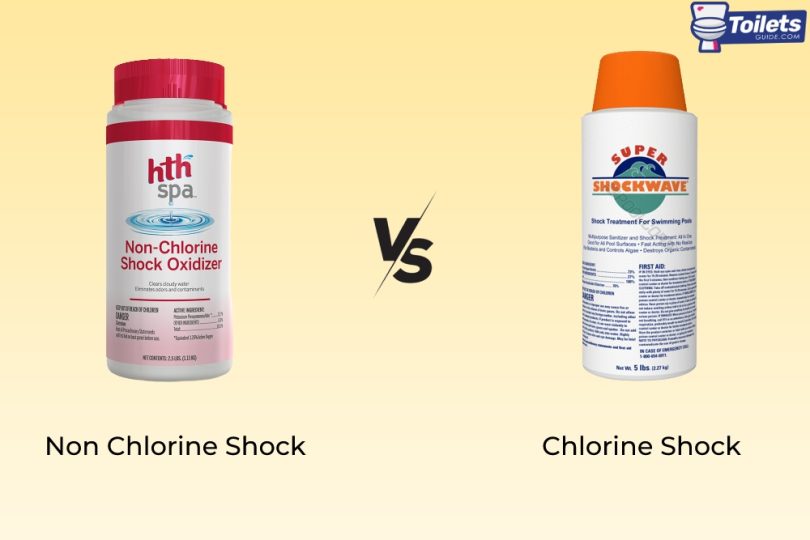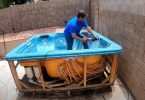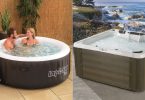The answer can go in many ways as there are many options available with their own sets of advantages and disadvantages. But here’s a quick way to make a good decision!
If your pool, spa, or hot tub has bacterial or algae contamination then it is good to go for chlorine-based shocks since they work both as a sanitizer and an oxidizer. You can use calcium hypochlorite as it is the cheapest and most balanced chlorine shock on the market.
Sometimes you may have to choose both because you may need to oxidize separately for high-traffic pools.
If you need a quick solution or in the case of hot water, there is no alternative other than non-chlorine shocks as chlorine shocks need much more waiting time and they can’t be used in warm water.
Note: Don’t mix dichlor/trichlor with calcium hypochlorite and bromine-based shocks with chlorine-based shocks because they can cause a dangerous chemical reaction.
What’s a non-chlorine shock?
Often called MPS (monopersulfate), non-chlorine shocks are odorless agents that contain oxygen combined with sodium or potassium salt. Here MPS or monopersulfate is short for potassium peroxymonopersulfate.
These potassium-based shocks are commonly used to perform oxidation (breaking down the organics and oils in water), which is different from sanitization (killing of bacteria) that chlorinated shocks do.

They are relatively safer than chlorine shocks since they don’t contain chlorine. You can quickly remove dead skin, sweat, dirt, and sunscreen in water within around 15 minutes.
If your pool or spa water is slightly polluted without any presence of algae in it, non-chlorine shocks will suit you best.
What’s a chlorine shock?

Chlorine shocks work both as a sanitizer and an oxidizer with the main function of killing bacteria and algae.
There are many different types of chlorine shocks with the most common one being calcium hypochlorite. Others are dichlor, trichlor, sodium hypochlorite, and lithium hypochlorite.
Non-chlorine Shock vs Chlorine Shock: How They Differ
| Comparing points | Non-chlorine shock | Chlorine shock |
| Method of action | Only oxidization | Sanitation and oxidation |
| Works better on | Dead skin, perspiration, dirt, and sunscreen | Bacteria and algae |
| Purpose | To decompose unwanted organic materials | To disinfect water killing microorganisms |
| Waiting time | About 15 minutes | 12 – 24 hours on average |
| Stabilizer (cyanuric acid) | Doesn’t produce any | Some varieties produce, some don’t |
| Odor | No odor | Strong odor of chlorine |
| Bleaches | Doesn’t bleach delicate materials | Bleaches clothes and soft surface areas |
| pH level | Has lower pH | pH level varies according to type |
| Price | Costs 10% more than chlorine shock | Cheaper except lithium hypo |
| UV light | No effect | Heavily affected |
| Removal action | Chloramines and ammonia | Chloramines and ammonia |
| Temperature | Can be used in any temperature | Can’t be used in hot or warm water |
| Residues formation | Doesn’t produce combined chlorine | Produces combined chlorine |
| Best for | Slightly polluted water | Heavily polluted water |
| Varieties | Fewer varieties available | More varieties available |
| Forms | Tablet and powder | Liquid, tablet, granular, and powder |
| Timing | Can be used anytime | Only when the sun is down |
| Shelf life | Comparatively shorter shelf life | 3-5 years if properly stored |
| Calcium level | Does not increase | Some varieties increase |
| Time of action | Quick | Quick except tablet forms |
| Overdosing management | Medium | Easy |
| Needed quantity | Comparatively less | Varies with types |
| Suitable for | All pool types | Indoor pools only |
| Side effects | No significant side effects | May cause skin irritation and red eyes |
| Mixing problem | Can freely use with any pool chemicals | Some varieties can’t be mixed |
| Using facility | Easy to use | Depends on types |
Different types of non-chlorine shocks
1. Sodium monopersulfate
Pros
- Odorless
- Ultraviolet rays don’t affect it
- Doesn’t burn eyes
- Doesn’t produce chloramines
- Doesn’t bleach swimwear
- Doesn’t affect water temperature
- Doesn’t cause itching on the skin
Cons
- Sterilization doesn’t happen
- Doesn’t kill bacteria and algae
- Can’t remove chloramines
- Lowers the pH level, which reduces the effectiveness of other chemicals
2. Potassium monopersulfate
Pros
- Only 15 minutes are needed to oxidize the contamination
- Improves chlorine efficiency if applied weekly
- Saves money since you don’t need to use much to get effective results (Only 2 lbs are needed for 10,000 gallons of water)
- Enhances water clarity
- Doesn’t increase calcium and chlorine levels
- Helps in enzyme treatments
- Doesn’t raise cyanuric acid levels
- Applicable in all types of pools
- Removes ammonia and chloramines
- Non-sensitive to sunlight that makes it possible to use any time
- Can be added directly to the pool water
- Odor-free
- Doesn’t cause irritation
- Water temperature doesn’t affect it and Can be used in both normal (78°F–82°F) and hot water
- Can be used with both bromine and chlorine
Cons
- Costs about 10% more than chlorine shocks
- Works only as an oxidizer and doesn’t kill bacteria or help control algae growth
- The alkalinity of the pool maybe reduced because it‘s low 2.3 pH level
- Increases the total dissolved solids (TDS) level
- Can give a false reading of combined and total chlorine levels as potassium reacts with monopersulfate
Different types of chlorine shocks
2. Calcium Hypochlorite (Cal-Hypo)
Pros
- The cheapest chlorine-based pool shock out there
- Kills bacteria and stops algae growth
- Does oxidation too, along with sanitization
- Fast-acting shock
- Quick-release and fast acting
- Removes ammonia and chloramine
- Can be found in different strengths
- Only about 1 lb is needed for 10,000 – 15,000 gallons of water
- Raises free chlorine without increasing cyanuric acid
- Easy to find as it is the most common type of shock
Cons
- High pH level
- Susceptible to UV rays
- Can’t be used any time you want, especially when the sun is bright
- Increases the calcium level of water
- Longer waiting time to work; i.e., 18-24 hours
- Bleaches swimwear, dark clothing, and hair
- Leaves combined chlorine as residues
- May burn the eyes and cause itchy skin
- Can’t be used in a spa or hot tub as calcium hypochlorite will be burned by the warm water
2. Sodium hypochlorite (Liquide chlorine)
Pros
- Relatively inexpensive
- Only 1 gallon is sufficient for 10,000 gallons of water
- Easy to manage if you over shock the pool because the sun burns off the chlorine over time
- Fast action
- Easy to use as you can apply it directly onto the water
- Perfect for high-traffic or commercial pools since it can be added in bulk
- Sodium hypochlorite is strongly alkaline in nature (pH – 13)
Cons
- Highest pH level among different types of chlorine shocks
- Bleaches out vinyl liners, paint, and sensitive or soft surfaces
- Long waiting time; i.e., 24 hours
- Need to add more acid to neutralize the pH level
3. Lithium hypochlorite
Pros
- Doesn’t raise the calcium level of the pool
- Quickly dissolves in water
- The pH level remains unchanged
- Doesn’t burn soft surfaces like vinyl liners or fiberglasses
Cons
- Most expensive of all pool shock options
- Doesn’t produce stabilizer like CYA (cyanuric acid), which protects chlorine from UV light
- Has a low FAC (Free Available Chlorine) level (28-30%) compared to some other chlorine shocks, which means you have to use a large amount to get good results
4. Dichlor and trichlor
Pros
- Suitable for pools with high levels of algae
- Not sensitive to UV rays
- Easy to use as they come in tablet forms
- Stabilizes chlorine as it contains cyanuric acid, which protects the chlorine from sunlight
- Self-maintaining as the tablet mixes slowly into the water
- Has the strongest chlorine concentration among the different chlorine-based shocks
- Long shelf life
Cons
- May raise cyanuric acid levels quickly because 1 ppm of chlorine produces 0.6 ppm of acid
- Can rust and stain your pool
- May increase the acidity of the pool (pH – 3)
- Slow in action as the tablets dissolve slowly
- Can’t be used with calcium hypochlorite or there will be a dangerous chemical reaction
- Has stabilizers (cyanuric acid) in high levels








Leave a Comment